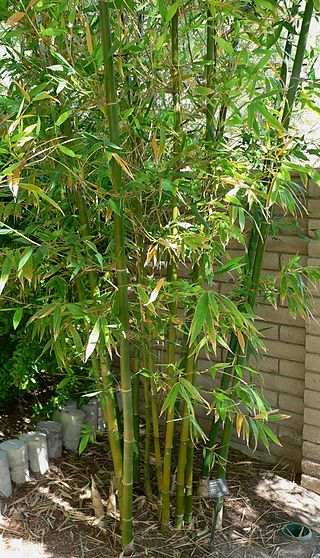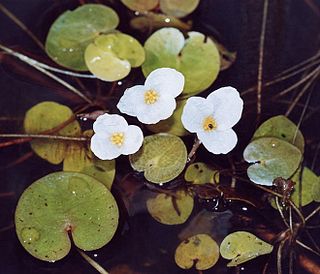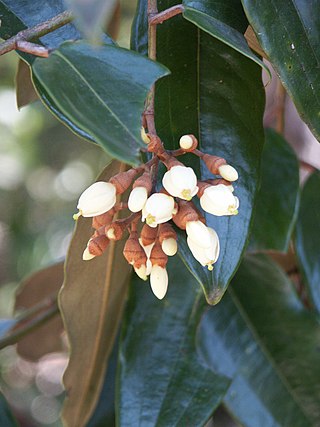| Najas | |
|---|---|
 | |
| Najas marina [1] | |
| Scientific classification | |
| Kingdom: | Plantae |
| Clade: | Tracheophytes |
| Clade: | Angiosperms |
| Clade: | Monocots |
| Order: | Alismatales |
| Family: | Hydrocharitaceae |
| Subfamily: | Hydrilloideae |
| Genus: | Najas L. (1753) |
| Synonyms [2] | |
| |
Najas, the water-nymphs [3] or naiads, is a genus of aquatic plants. It is cosmopolitan in distribution, first described for modern science by Linnaeus in 1753. Until 1997, it was rarely placed in the Hydrocharitaceae, [4] [5] [6] [7] and was often taken as constituting (by itself) the family Najadaceae. [8]
The APG II system, of 2003 (unchanged from the APG system, of 1998), places the genus in family Hydrocharitaceae, in the order Alismatales of the monocots. [7]
An infrageneric classification of two sections is proposed: Section Americanae and sect. Caulinia. [9]
- Species [2]
- Najas affinis Rendle - South America, Senegal, Guinea-Bissau
- Najas ancistrocarpa A.Braun ex Magnus - China, Japan, Taiwan
- Najas arguta Kunth - Cuba, Costa Rica, Panama, South America
- Najas australis Bory ex Rendle - India, Madagascar, Mauritius, KwaZulu-Natal, Seychelles
- Najas baldwinii Horn - West Africa
- Najas brevistyla Rendle - Assam
- Najas browniana Rendle - southern China, India, Taiwan, Java, Cavern Island in Northern Territory of Australia
- Najas chinensis N.Z.Wang - Primorye, China, Taiwan, Japan
- Najas conferta (A.Braun) A.Braun - Cuba, Hispaniola, Panama, Brazil
- Najas faveolata A. Br. ex Magnus
- Najas filifolia R.R.Haynes - southeastern United States (Georgia, Alabama, Florida)
- Najas flexilis (Willd.) Rostk. & W.L.E. Schmidt (1824) - temperate Northern Hemisphere
- Najas gracillima (A.Braun ex Engelm.) Magnus - Asia, North America
- Najas graminea Delile (1813) - Africa, Asia, New Guinea, Melanesia, northern Australia; naturalized in California and parts of Europe
- Najas grossareolata L.Triest - Sri Lanka
- Najas guadalupensis (Spreng.) Magnus - North and South America, Caribbean
- Najas hagerupii Horn - Ghana, Mali
- Najas halophila L.Triest - Java, New Guinea, Queensland
- Najas heteromorpha Griff. ex Voigt - eastern India
- Najas horrida A.Braun ex Magnus - Africa, Madagascar, Sinai
- Najas indica (Willd.) Cham. (1829) - Indian Subcontinent, China, Southeast Asia, New Guinea
- Najas kurziana Rendle - Bihar, East Timor
- Najas madagascariensis Rendle - Madagascar; naturalized in Mauritius
- Najas malesiana W.J.de Wilde - India, Bangladesh, Indochina, Malaysia, Indonesia, Philippines; naturalized in eastern Brazil
- Najas marina L. (1753) - widespread and nearly cosmopolitan
- Najas minor All. (1773) - widespread in Europe, Asia, Africa; naturalized in eastern North America
- Najas oguraensis Miki - East Asia, Himalayas (Pakistan, Nepal, northern India)
- Najas pectinata (Parl.) Magnus - Sahara
- Najas pseudogracillima L.Triest - Hong Kong
- Najas rigida Griff. - eastern India
- Najas schweinfurthii Magnus - Senegal, Cameroon, Ethiopia, Sudan, Tanzania
- Najas tenuicaulis Miki - Honshu Island in Japan
- Najas tenuifolia R.Br. - Hong Kong, Southeast Asia, Australia
- Najas tenuis Magnus – India, Sri Lanka, Myanmar
- Najas tenuissima (A.Braun ex Magnus) Magnus - Finland, Russia, Hokkaido
- Najas testui Rendle - western + central Africa
- Najas welwitschii Rendle - tropical Africa, western India
- Najas wrightiana A.Braun - Mexico, Central America, Cuba, Bahamas, Venezuela; naturalized in Florida















